This year marks 40 years since Katharine Hamnett launched her first series of slogan t-shirts, including the legendary Choose Life. Putting your feelings on your chest—especially in huge, black letters—might make other people think about certain issues too, was her reasoning at the time. Meanwhile, she figures that slogans don’t really work and that the only way to achieve real change is by legislation — voting the bad ones out and the good ones in. But, at that time, the tees were a huge hit with millions sold, being worn by George Michael, Madonna, Mick Jagger, Oprah, Naomi Campbell, and more recently Dua Lipa and a lot more artists and social activists.
The slogans may not work on a political level, but they sure do in other ways: Katharine donated her slogan Choose Love to the organization with the same name that’s working with refugees. Since then, they’ve raised over 100 million £. And when Naomi Campbell wore a Use One top in South Africa, HIV prevention became an important subject in the news.
The first time Ninette Murk met Katharine was at a fair in Berlin where Murk was with her first collection of tees for Designers against AIDS and Hamnett was checking out sustainable manufacturers. They spoke briefly and Murk asked her if she wanted to create a few slogans for our T-shirts and she sent them over straight away. The next time they worked together was for the project Fashion against AIDS that Murk created with H&M. It ran for 5 years worldwide and raised 13 million euros for HIV prevention organization. Katharine took part in two of the collections, each time with two new slogans. Again, they met in Paris in 2008 at the launch of the first collection in Colette and had dinner afterwards with the entire team, having the chance to briefly speak.
Fast forward to 2022. Murk was doing consultancy for the Global Goals app that Samsung created with UNDP and it was (and still is) her job to add pop culture and interesting people who give a suggestion or two to young people about making the world a better place at home, in their community, and beyond. Katharine doesn’t ‘do’ just one or two tips — she was so enthusiastic that not only did she make a video with her most important tip (VOTE!), but she also suggested making a line of sustainable t-shirts and hoodies with slogans relating to The Global Goals, a QR Code leading the app/website and donating 20% of all sales to UNDP. Together they produced the ‘We Are The Future’ video featuring young people wearing the tees and explaining each of The Global Goals. It was made without a budget and ended up winning one of the Prizes at the Smiley Charity Film Awards a few months later.
Using those t-shirts and hoodies, Murk created a shoot with British creatives and social activists of all ages who explain why their engagement is so important and how the work of Katharine Hamnett has influenced them.
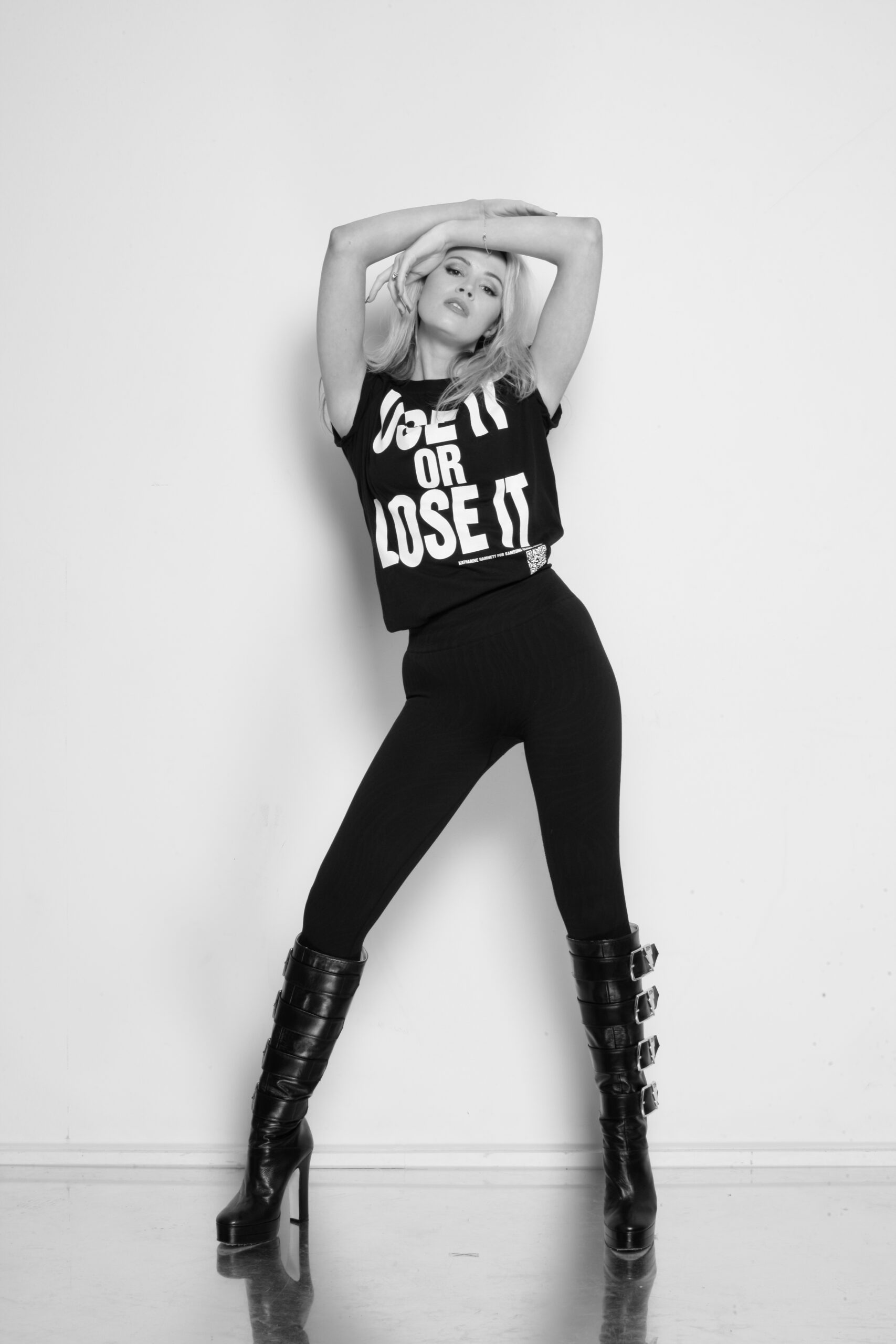
t-shirt. Katharine Hamnett for Samsung Global Goals x UNDP
Olivia Arben, model and British Heart Foundation ambassador
Please share a story about your personal activism that you feel encapsulates your mission and ethos.
I’m honoured to be one of five officially appointed female British Heart Foundation Ambassadors, alongside Pippa Middleton, Sarah Ferguson the Duchess of York, Dame Esther Rantzen and Dr Hazel Wallace. The British Heart Foundation is close to my heart as my father passed away from a heart attack aged just 53, when I was 16. I work with the British Heart Foundation to raise awareness for heart disease in the younger generation and females in particular, through my social media platforms and the use of my fashion connections to help us promote the British Heart Foundation’s charity stores, which are a major source of revenue for the charity, with the added bonus of promoting sustainability.
What does the message on the slogan tee shirt you wore in the shoot mean to you? What is your interpretation?
‘Use it or lose it’ is the message on my t-shirt, I would say it applies to everything in life and if you are lucky enough to have a platform you should use it to promote positivity!
Do you feel like change can be made through the relationship between fashion and politics? If so, how?
Yes, I do! Last year I was appointed an Ambassador for British Fashion by our Parliament which has been a huge honour and influenced my views so much. Clothes play a significant cultural role in creating a sense of belonging, unity and collective identity in the community which in turn can influence political matters in a big way.
What are your memories and associations of Katharine Hamnett’s work and career?
Of course, she is best known for really being the first designer to create the slogan t-shirt. She is a bold lady and a trailblazer for activism in fashion! We are all standing on her shoulders – and are proud to do so!
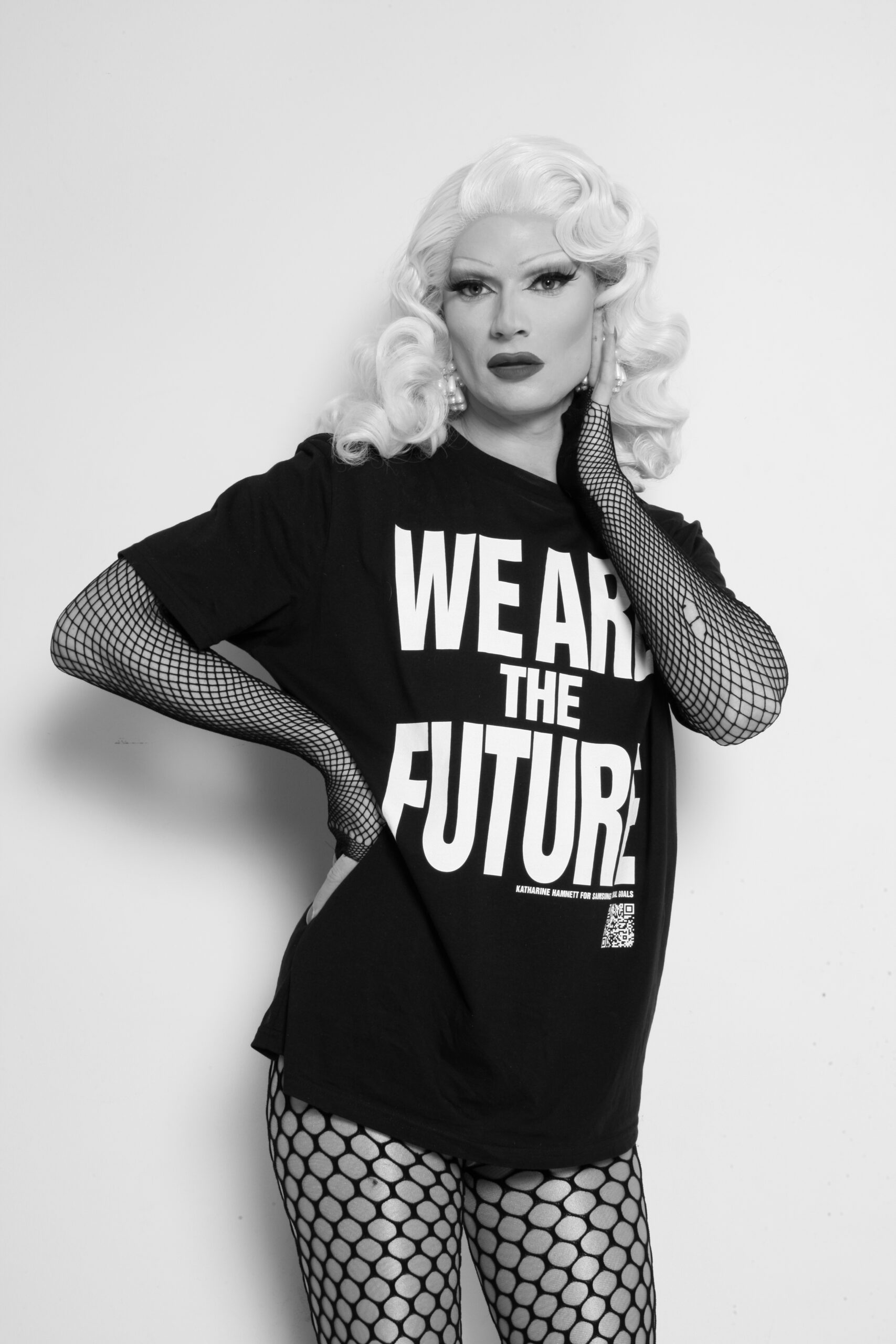
t-shirt. Katharine Hamnett for Samsung Global Goals x UNDP
Jonbers Blonde, artist/performer
Please share a story about your personal activism that you feel encapsulates your mission and ethos.
I think doing drag or dressing your own unique way is a political statement and activism against everyday boundaries. As someone growing up in the troubles of Northern Ireland, doing drag and being queer was incredibly dangerous. I remember once we were sitting by the main window of the club and someone threw a glass bottle and it smashed on someone’s face while we were just sitting down on a night out, all be it all of us were in drag. Being your true authentic self is the biggest activism you can do as a queer person.
What does the message on the slogan tee-shirt you wore in the shoot mean to you? What is your interpretation?
My slogan of “We are the future” is actually quite poignant at this time with what is not only happening in America and banning drag, the laws passing in Uganda and in the UK where the government are taken strong action against the trans community and taking away rights which have been in place for years. The higher powers are slowly seeing the gain of the queer community being happy and thriving, and this doesn’t sit well with the left wing. They are deflecting huge misconduct within their cabinets by pointing at us and to quote Jaida Essence Hall ‘look over there.’ This is another Brexit situation where they are saying ‘we will fix it, listen to us this is what we will do,’ but look how that turned out! As a community we have always had to fight, there is no change there, but luckily we have social media, media outlets and people in government who can make change and stand up.
Do you feel like change can be made through the relationship between fashion and politics? If so, how?
I believe change can be made if enough people are willing to get behind a campaign. I think fashion encapsulates any political statement – it has the power to change your look. How you want to come across from wearing a suit to a skirt as a gender Jon-conforming person, that insert is political. The fashion community is such a strong one, with incredible power behind it. The ethos of how ethical clothes are being made, and the amount of plastic being reduced in packaging all these changes are small but integral for the planet and human beings.
What are your memories and associations of Katharine Hamnett’s work and career?
The word iconic gets thrown around a lot in today’s society and social media but Katherine’s work and pieces of clothing are the true meaning of iconic. Something that has stood the test of time and actually has meaning and guts to it.
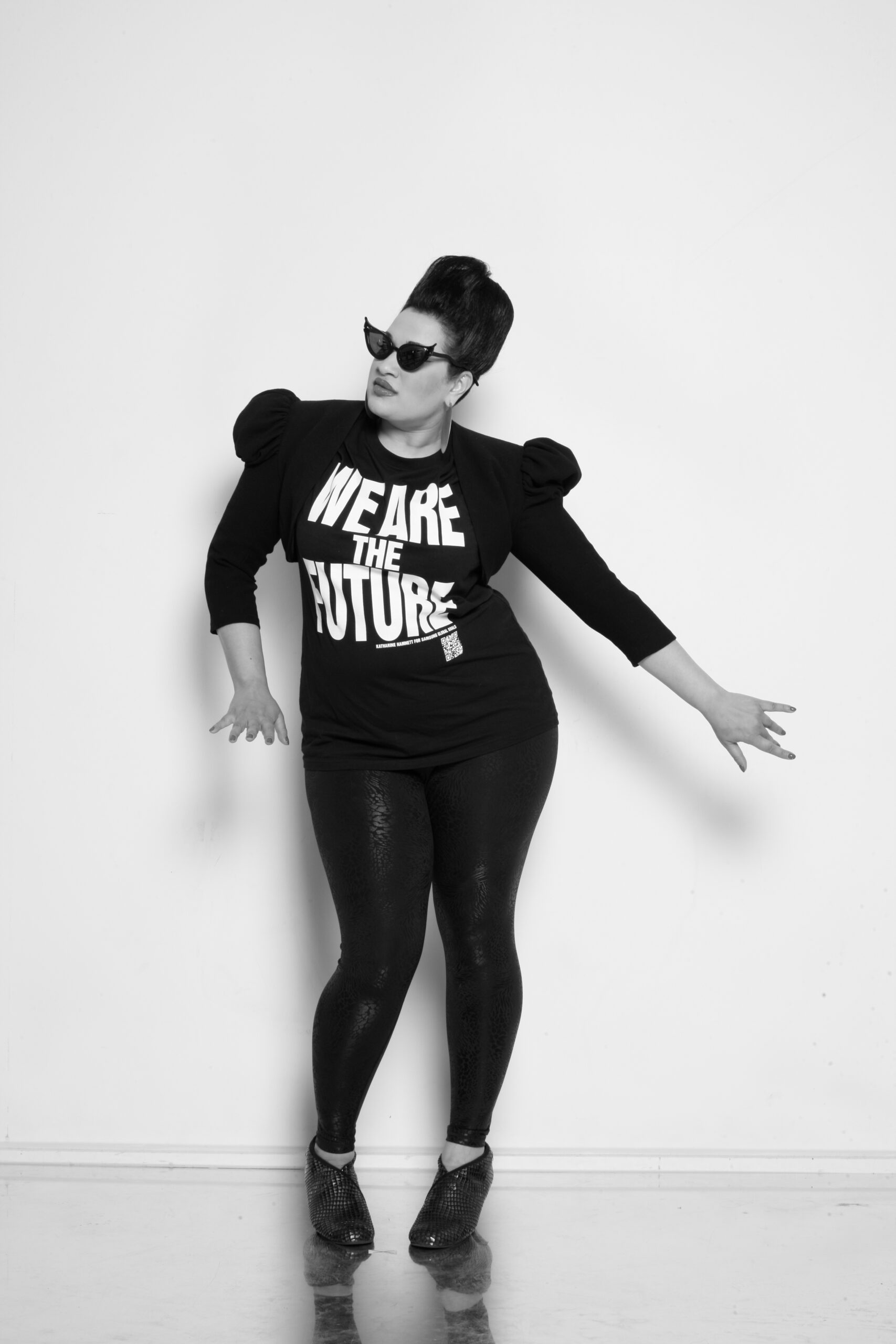
t-shirt. Katharine Hamnett for Samsung Global Goals x UNDP
Bishi, musician
Please share a story about your personal activism that you feel encapsulates your mission and ethos.
I have been active in spaces that directly relate to my artistic practice: women, trans and non-binary in music and music tech, women of colour in the arts and women of colour in the music industry. In the last decade, there’s been incredible momentum around opening up conversations for marginalized identities. I believe that although the change has been incremental, I am energized by the types of conversations emerging for people, as they were not even possible even 5 years ago.
What does the message on the slogan tee shirt you wore in the shoot mean to you? What is your interpretation?
The slogan I’m wearing is ‘We Are The Future,’ and it speaks to why I love Katharine’s work so much. Each slogan is open to interpretation. It transforms with each wearer. To me, it gives me the energy to seize the day!
Do you feel like change can be made through the relationship between fashion and politics? If so, how?
As I believe the personal is political, I believe that fashion is political, as fashion is one of the most personal modes of expression. Fashion has played a historically pivotal role in the conversations around race, gender and power, no more so than it is central in today’s conversations in questioning societal conventions.
What are your memories and associations of Katharine Hamnett’s work and career?
As I was too young to have any conscious memories of the 1980s, by the time I was learning about pop culture and fashion growing up in the 90s, Katharine Hamnett’s work already felt like cultural DNA. What’s always fascinated me about her work, is that it has transcended time, race, pop culture and nationality and become iconic in its own right.

t-shirt. Katharine Hamnett for Samsung Global Goals x UNDP
Namalee Bolle, psychotherapist/artist/activist
Please share a story about your personal activism that you feel encapsulates your mission and ethos.
For me, style has always been directly related to personal expression and therefore personal power, identity and mental health – and that’s why I eventually trained as a psychotherapist after starting out as a fashion editor.
I co-founded SUPERSUPER! magazine at a time when fashion/ style was extremely elitist and pretty racist too, in a desire to inspire people to express themselves and have fun with fashion, without feeling they have to spend too much money. The premise was inspired by my Sri Lankan mum and her colourful optimistic dressing – I guess people call it ‘dopamine dressing’ now, but my mum always dressed that way and it was empowering for me to watch her growing up where I grew up in a very conservative area. I always felt like her fashion was an unconscious message about her identity and culture, without having to speak it with words, and I learnt how to make a statement with what you wear by watching her.
What does the message on the slogan tee shirt you wore in the shoot mean to you? What is your interpretation?
Well, it’s just one word ‘Vote!’ And I guess it’s a straightforward direct call to action, which appeals to me. I will always vote, even though to be honest, what a mess we are in with the left. I feel like most politicians need to have therapy to learn some self awareness, and how intergenerational trauma affects their politics, before being put in charge of people whose lives they don’t understand whatsoever.
Do you feel like change can be made through the relationship between fashion and politics? If so, how?
I always lived by this understanding in my fashion career. I find the personal political and so wearing something can be a very political act. For example, wearing day-glo colours during the early noughties felt like a statement of self-expression about colour = race. The way I have used fashion in my career is distinctly political – to express my cultural and mixed heritage and to explore how I feel about that through using ‘clashing’ juxtapositions of clothing (as cultures) in my styling work.
What are your memories and associations of Katharine Hamnett’s work and career?
I worked with Katharine as her stylist for quite a few years, which was a dream job. Katharine is a real-deal humanitarian badass, and she genuinely cares – what you see, it’s all real – no ‘brand’ fakery. I also remember her proactively wanting to use models of colour when the industry at that time was still quite racist. She has been very personally inspiring to me and loved what we were doing at SUPERSUPER! I fondly recall her giving me career advice over a cuppa whilst her dog Arthur was snuggling us (he came on the shoots too!). Long live Katharine the Great! To me, she’s the epitome of cool, full of integrity.
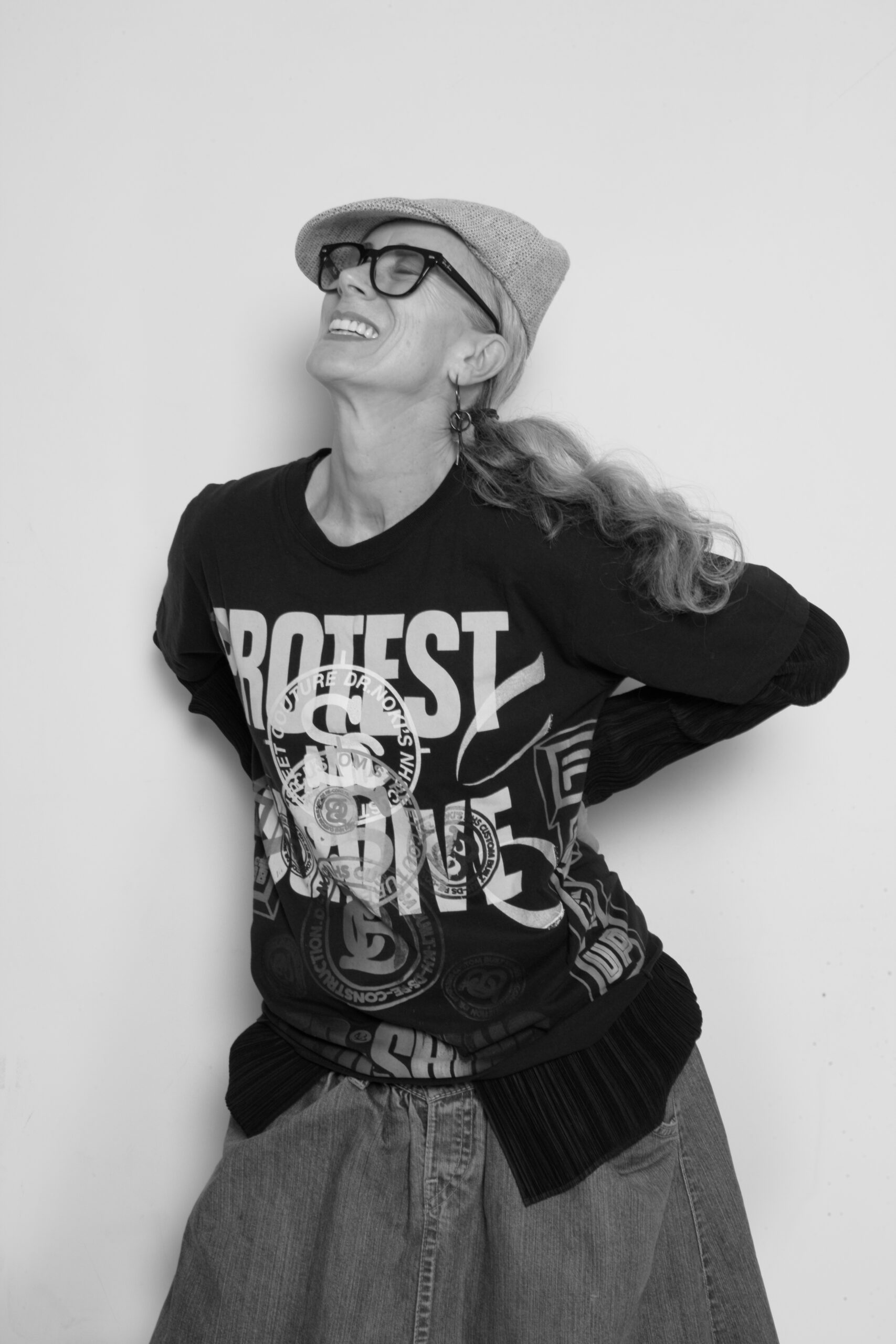
t-shirt. Katharine Hamnett for Samsung Global Goals x UNDP
Caryn Franklin, fashion and identity commentator
Please share a story about your personal activism that you feel encapsulates your mission and ethos.
All Walks Beyond the Catwalk was a campaign I co-founded in 2009 to challenge unachievable body ideals in our fashion media. We began by creating shoots depicting age, race, size and difference and linked up with powerful image makers, and designers. We collaborated with i-D, London Fashion Week and the National Portrait Gallery to promote a broader range of body and beauty ideals and we got a huge amount of national and international press, with the then prime Minister’s wife Sarah Brown endorsing us.
At the time designers did not make sample designs in larger sizes and you rarely saw older or size diverse women in the media or on the catwalks. Studies confirm how damaging the fashion and media norms of passive, perfected, thin white teenagers as the only representation of beauty are for most girls and women. By 2015 we had 38 fashion universities committed to more diverse practice covering making and media. We worked with two Government Ministers of Equality, responsible for educational and social policy and we created the Diversity Network in Edinburgh. I believe we helped to trigger a mass shift in the perception of body norms. Social media means that this challenge is now taken up by some powerful body-positive influencers. I’m thrilled to see that there are important conversations and alternative opinions out there for our young women.
What does the message on the slogan tee shirt you wore in the shoot mean to you? What is your interpretation?
Protest and Survive is a call to arms. If we don’t like it we have to change it. There are so many brave humans out there who risk life to protest against brutal political regimes. Most of us are lucky enough to engage more comfortably. And we must engage.
Do you feel like change can be made through the relationship between fashion and politics? If so, how?
Fashion is political. Women in particular are repeatedly prompted to pay attention to their image and conform to narrow ideals. Apart from a lack of inclusivity, campaigns and other fashion messaging also prioritize the white male gaze. Women are sexualised even dehumanised in fashion imagery. Meanwhile, global north, white male leadership teams reap exaggerated profits from fashion production margins, while global south garment workers (often Black or Brown female makers) are on poverty wages. We have all been price-bribed because the economic policies that came with globalization only benefited Western nations. Now many of us expect cheap, fast fashion and as consumers, we don’t calculate the true cost to the rest of the world and indeed the planet. I don’t have all the answers, but I choose not to be a mindless consumer when I can be a citizen participant. I’m making much more discerning choices now, and so are my daughters.
What are your memories and associations of Katharine Hamnett’s work and career?
I’d like to thank Katharine for being so vocal in the 80s, at the start of my career. She was a huge influence on me because she was outspoken and refused to toe the line. Everyone knows about her famous ’58% DON’T WANT PERSHING’ t-shirt, worn to visit Prime Minister Margaret Thatcher, but she was amongst the first on the international fashion circuit, to talk about sustainability. This is a hazy memory but when I was a journalist broadcaster in the early 90s, I remember being in Milan queuing for her show. We were at the door and were told that she would be showing only a small selection of clothing. She had just pulled a large part of the collection, having learned that the fabrics contravened her sourcing standards. There was a lot less provenance transparency back in the day and I remember thinking she was a QUEEN.
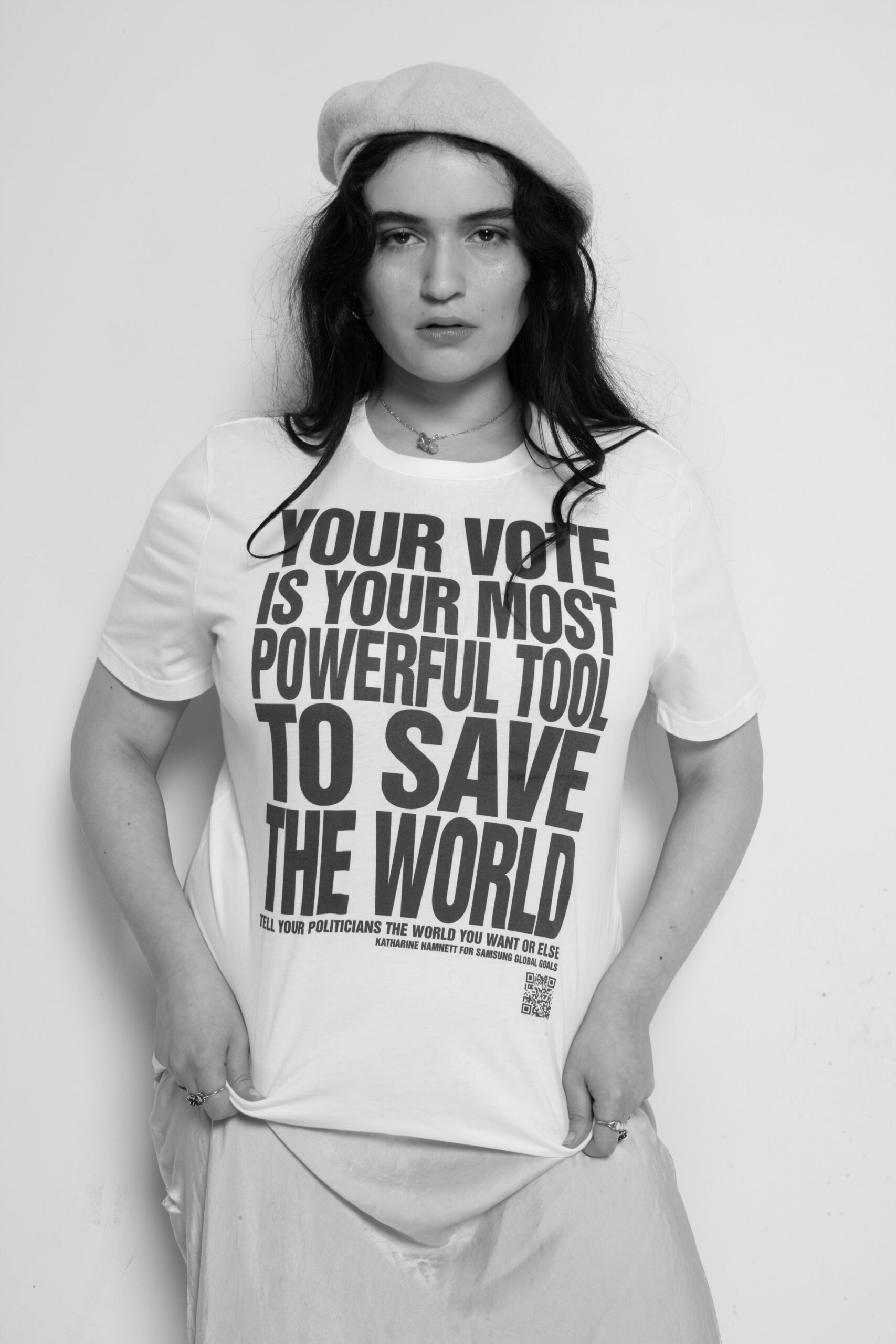
t-shirt. Katharine Hamnett for Samsung Global Goals x UNDP
Yasmin El Yassini, actress and vintage archivist
Please share a story about your personal activism that you feel encapsulates your mission and ethos.
I practice transcendental meditation and after feeling the effects I feel as though it’s something everyone deserves. This is also the ethos of the David Lynch Foundation set up so that everyone in the world who wants to can learn TM. The very profound inner peace gained would cause an external and internal revolution for anybody who learns it, especially those who have experienced trauma, which by this point our social consciousness has grown to understand, is just about everyone.
What does the message on the slogan tee shirt you wore in the shoot mean to you? What is your interpretation?
‘Your vote is your most powerful tool to save the world.’ – Tell your politicians the world you want or else that we have a right to vote! As a voter we are all equal – whatever background we have – whatever class. It’s a powerful tool for change. Even though I’m completely at odds with my outlook on all current politicians, the lesser evil will always be the lesser evil.
Do you feel like change can be made through the relationship between fashion and politics? If so, how?
Yes absolutely, getting dressed every morning is a political choice, perhaps now more than ever. I chose to only wear vintage used second-hand clothing. Everyone else should too – we can’t keep producing plastic at this endless rate.
What are your memories and associations of Katharine Hamnett’s work and career?
I am lucky enough to own 2 vintage Katharine Hamnett pieces – one 80’s shirt that’s beyond divine and has very 1800s vibes and a silk shirt that’s just a dream. She changed fashion with sloganeering and empowerment in a way that’s now seen all over the industry from high fashion to high street for the past 40 years.
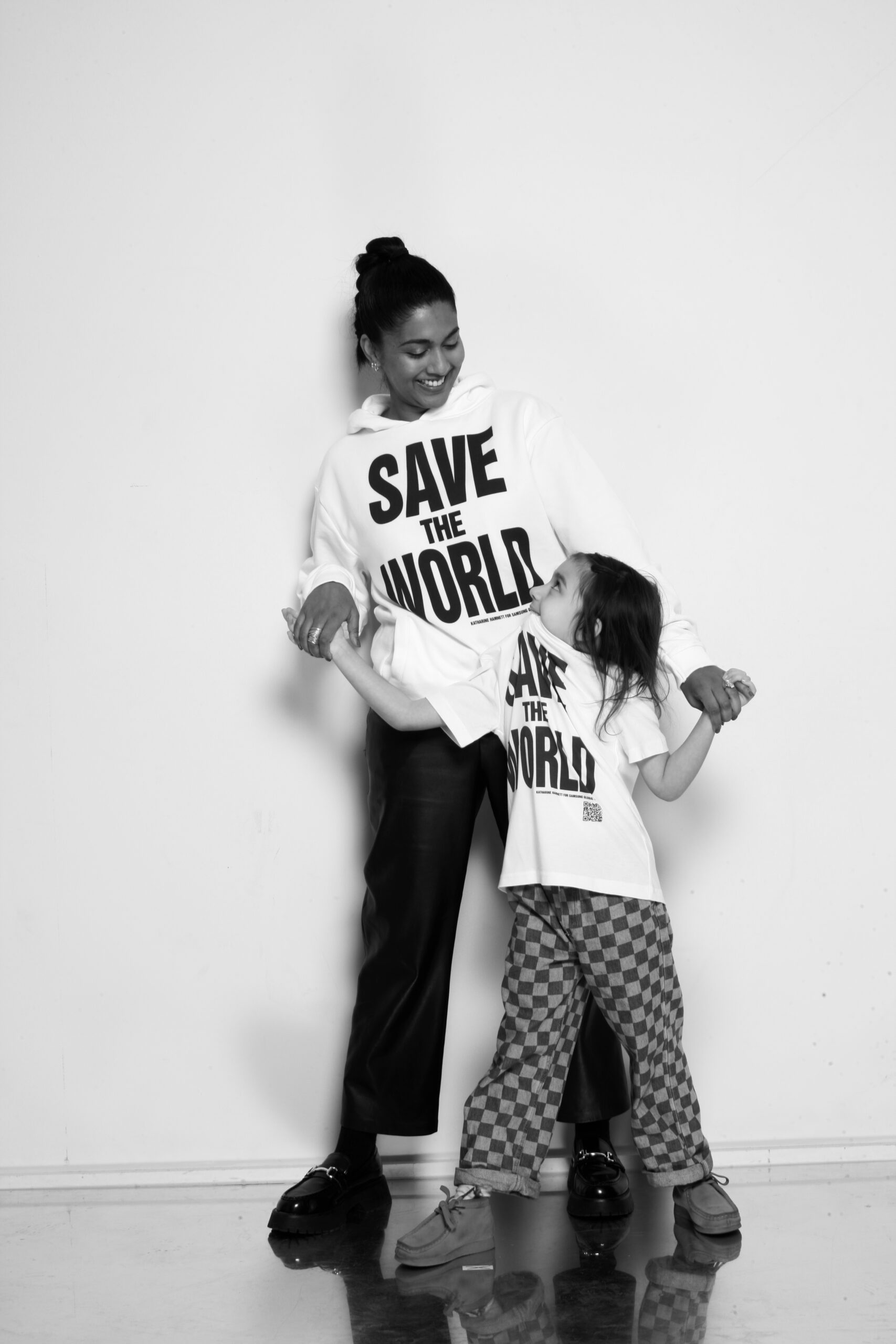
hoodie + t-shirt. Katharine Hamnett for Samsung Global Goals x UNDP
Meryl Fernandes, CBBC TV presenter and co-owner of The Duke of Richmond pub + Freddie
Please share a story about your personal activism that you feel encapsulates your mission and ethos.
During COVID-19, we handed out 300 free kids lunches a day during the school holidays, and we ran a weekly soup kitchen providing meals for our local doctors and nurses at Homerton Hospital. We have also provided food hampers for local vulnerable families during the Christmas period all from our pub in Hackney. It became very apparent during COVID-19 how many families were struggling to feed their kids in Hackney, with the schools being closed. We decided to raise money and provide as much as we could to help these families out.
As parents ourselves, we realized we had to step up: we had the space and the team (who all volunteered to make the lunches) and our wonderful, generous customers and suppliers donated a total of £8k. We worked closely with Hackney Foodbank, Community Food Hub and Hackney Quest. As pub owners, we felt a strong duty to our community. We wanted to create a hub where locals could pick up as many lunches as they needed and no questions would be asked. It didn’t matter what your situation was, if you needed food then we provided it. No child should ever go hungry was the only thought we had during that time, and of course we still feel the same now. There is still so much more to do.
What does the message on the slogan tee shirt you wore in the shoot mean to you? What is your interpretation?
I believe we all need to look out for each other, help each other, care for each other, respect each other and fight to make the world a better place just as Katharine says. We need to come together as communities (no matter how small). We must pile on the pressure and fight for change in order to ‘save the world’.
Do you feel like change can be made through the relationship between fashion and politics? If so, how?
Historically, fashion has always had a relationship with politics. I think change can be made as fashion definitely reflects the zeitgeist and can be used as a vehicle for change. However, I feel we need more Katharines! – more designers to stand within the political world and make a louder noise by using their powerful platforms to influence and engage the youth and ultimately the youth vote in order to implement change in the political landscape.
What are your memories and associations of Katharine Hamnett’s work and career?
My first memory is the icon George Michael in his video wearing the ‘Choose Life’ t-shirt. It was as a teenager that I became more aware of Katharine’s work and values concerning sustainability and the environmental impact the fashion world has on our planet. She is probably the first designer/brand I was ever fully aware of – the oversized t-shirt with the block lettering slogans that made you feel and ultimately think. The original influencer.
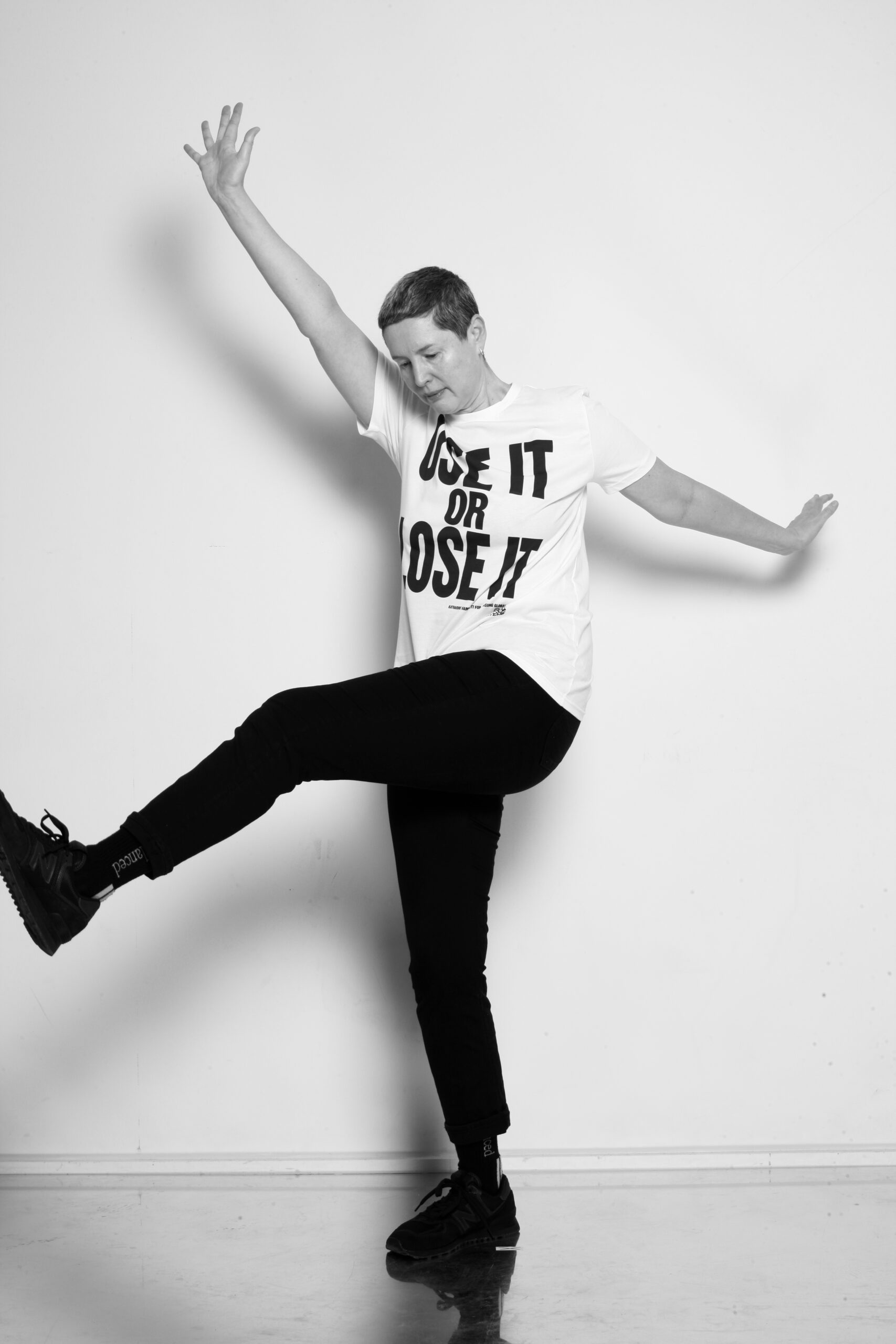
t-shirt. Katharine Hamnett for Samsung Global Goals x UNDP
Cozette McCreery, fashion consultant
Please share a story about your personal activism that you feel encapsulates your mission and ethos.
I have always felt very strongly in using my voice and privilege in a way that supports others, especially in the LGBTQ+ community, a community that has always supported me as a cis white woman since coming to London and going to clubs at 15. I am also extremely proud to have been one of the 4 fashion professionals setting up the Emergency Designer Network making scrubs and gowns for numerous NHS trusts at the beginning of the pandemic and the years that followed. We worked with garment factories directly (all of us on a voluntary basis) when the government refused our support. It’s still my mission to question anything the government tells me is OK, which I think is also very Hamnett.
What does the message on the slogan tee shirt you wore in the shoot mean to you? What is your interpretation?
I think any message from Katharine is considered, relevant and I’d happily wear it and stand by it. Anything to start a conversation even if that conversation is against the slogan.
Do you feel like change can be made through the relationship between fashion and politics? If so, how?
All of us in the fashion industry are given an incredible platform to speak from. Whether you are just starting out and have very few followers or are established with millions, we can’t underestimate that power and should use it and use it wisely.
What are your memories and associations of Katharine Hamnett’s work and career?
I have so many as am a huge fan and over the years have brought and worn a lot of her designs. The first was an oversized men’s cotton velvet shirt from Joseph. I was lucky that my father knew him and his brother so I had a hefty discount. I wore it until it went bald at clubs and while doing my A levels. I also brought a cotton version at her incredible shop in Brompton Road only to be asked to leave my bags at Selfridges during an IRA bomb scare. Leaving my bag was not an option I told security in not so many polite words.
I have a striped shirt with silver buttons from the James Bond collection. The cotton bubble skirt and the pink cashmere 3 piece I wore with cheap pearls brought at Oxfam were again, worn to rags. I probably have that catalogue somewhere, it was incredible: a curvy model for a start! I still remember the disappointment in finding out that the cashmere tight-as-zip front jumpsuit wasn’t produced. A crushed velvet hot pants suit with Wolford high shine thick tights and Shelly’s Cuban heels was topped off with the straight off the catwalk headband with added long bob half wig attached. Placed over my crew cut I probably looked mental. And there’s thankfully no photographic evidence but I remember Nicola Bowery and I deciding it was a good look. A kind of extreme mullet!
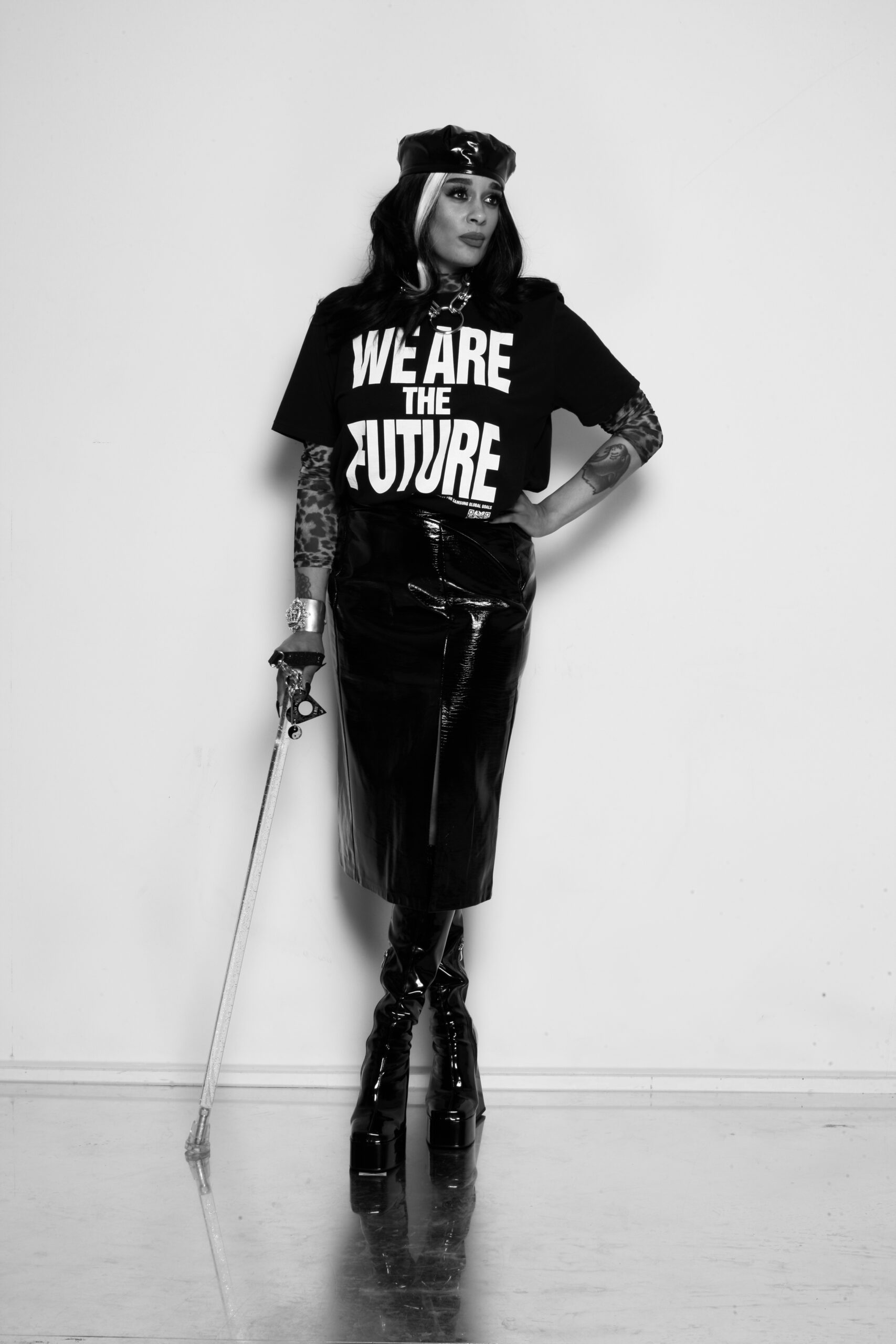
t-shirt. Katharine Hamnett for Samsung Global Goals x UNDP
Roxy Murray, Disability rights activist and sex-positive podcaster
Please share a story about your personal activism that you feel encapsulates your mission and ethos.
My Ethos is #WeAreNotInvisible and my activism journey is based on the empowerment of disabled individuals. Creating visibility, championing sexual empowerment, medical care and treatments that work for everyone. Using fashion as a way to engage focus I use my voice and visibility to advocate for better education treatments for ethnically diverse and queer individuals with multiple sclerosis. Taking part in both steering groups, talking directly to NHS decision makers and doing so with a touch of style.
What does the message on the slogan tee shirt you wore in the shoot mean to you? What is your interpretation?
The T-shirt slogan I chose was” We Are The Future.” I chose this slogan as a disabled individual because I believe that the disabled community is a massive part of how the future of the world is and will be shaped. Whether that be our accessibility rights, technological advancements or the fashion industry being adaptable. We are the natural rebels. What we fight for enhances everyone’s lives and shapes the future of society.
Do you feel like change can be made through the relationship between fashion and politics? If so, how?
The relationship between fashion and politics is so powerful and something I use on my own personal journey. Fashion challenges the norms and reflects society’s dreams. Fashion has always been at the forefront of change and always will be. We adorn our bodies to dress for our revolution. This has been a reality for decades. Politics now informs designers’ creations and helps to dictate our fashion choices – from sustainability to societal issues. Designers are choosing to create and implement politics in their brands. Adaptable fashion especially is a political revolution in itself designing clothes for individuals whom society often forgets. Creating both visibility and beauty gives a group of people the ability to be heard and seen as we were not before.
What are your memories and associations of Katharine Hamnett’s work and career?
The first memory I have of encountering Katharine’s work was an image from her summer 04 collection where Naomi Campbell was wearing a sheer black top adorned in diamantés with the words “use a condom” – Promoting aids awareness. I found it both provocative and powerful and a natural combination to gain attention and promote change. There are so many iconic political fashion moments in Katharine’s career. I was instantly inspired upon discovering her work. The revolutionary moment when she wore the “58% DON’T WANT PERSHING” to meet Margaret has never left my mind the actual revolution and punk move to use fashion as a way of communicating people’s true wants and needs.
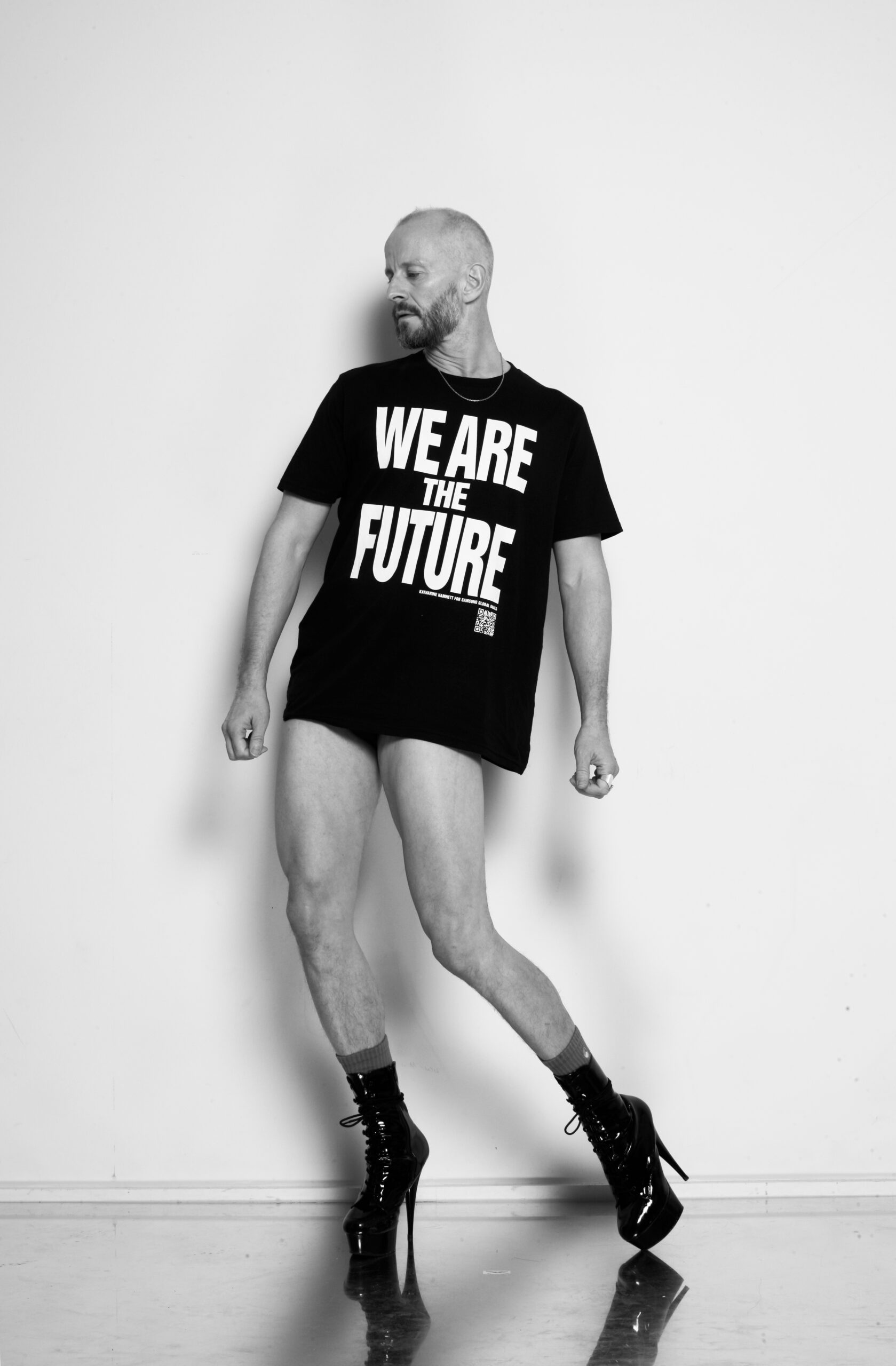
t-shirt. Katharine Hamnett for Samsung Global Goals x UNDP
Jonny Woo, performer
Please share a story about your personal activism that you feel encapsulates your mission and ethos.
I don’t consider myself an activist and I think I could be more proactive in standing up for issues that matter to me. That said, there is a lot of activism in simply being your true authentic self in a world which might prefer you to be otherwise. In terms of my curation of events and provision of spaces for queer people, I try to help others make their voices heard.
What does the message on the slogan tee shirt you wore in the shoot mean to you? What is your interpretation?
It’s very literal really. I think it’s as much a bond with ourselves – that we make the decisions as to what tomorrow will look like. It can be a call to arms, but it can also be an acceptance that the shape of the world in years to come, for future generations, is our own personal responsibility.
Do you feel like change can be made through the relationship between fashion and politics? If so, how?
I think there are exceptions with people like Katharine Hamnett and Vivienne Westwood, but on the whole, fashion might comment on politics, but ultimately next season the very nature of the industry demands that it sells you something else. Hamnett herself commented on racism within the industry years ago and it’s only recently fashion has started playing catch up. I think personal style can indicate your political ideology and what people wear can challenge cultural assumptions but I think the fashion industry, whilst hugely creative and wonderful at its most base level is ultimately capitalist and really wants to sell you clothes.
What are your memories and associations of Katharine Hamnett’s work and career?
I think as a teenager of course I remember Wham! wearing her clothes and she made headlines meeting Thatcher. I’ve always regarded her as one of the few who kept her political ideology at the forefront of her brand and she showed some work at The Glory recently and I was like, “Wow!”
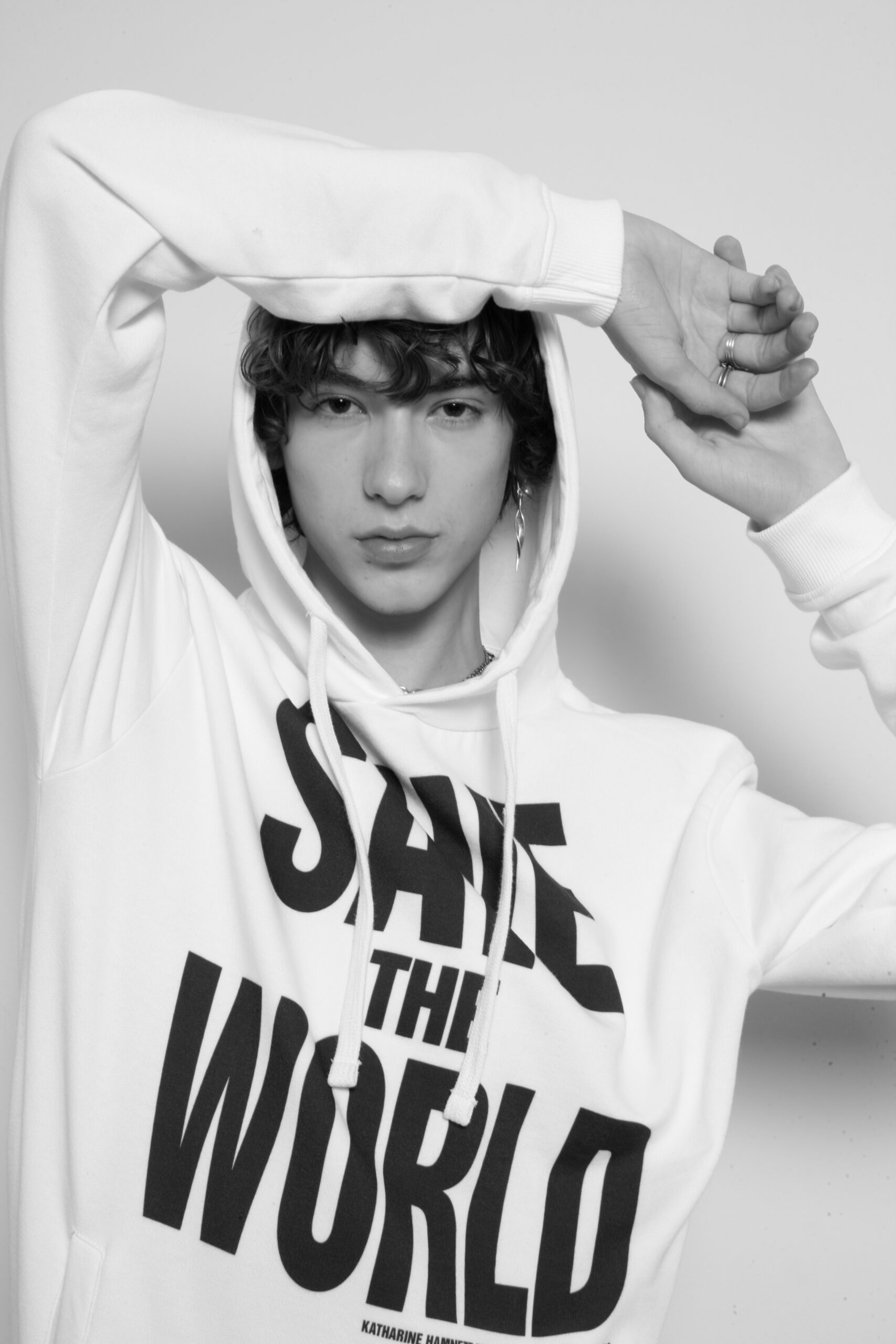
hoodie. Katharine Hamnett for Samsung Global Goals x UNDP
Daniel Millar, Actor
Please share a story about your personal activism that you feel encapsulates your mission and ethos.
I think the initial ‘Black Lives Matter Protests’ in response to the murder of George Floyd encapsulates my belief that activism through collective action is the most impactful way in which to enact change.
What does the message on the slogan tee shirt you wore in the shoot mean to you? What is your interpretation?
I interpreted the slogan plainly as a powerful call to action which can become even stronger through creative mediums such as fashion.
Do you feel like change can be made through the relationship between fashion and politics? If so, how?
Absolutely! I believe fashion, like all art, has a unique ability for communities to communicate across linguistic barriers thus making it an influential tool for global activism.
What are your memories and associations of Katharine Hamnett’s work and career?
I think my earliest memory of Katharine’s work was the “Choose Life” slogan t-shirt I saw in Vogue in 2017 which struck me in its influential simplicity. It didn’t overcomplicate the message in a pretentious way that much activist art seems to do which made it refreshing.
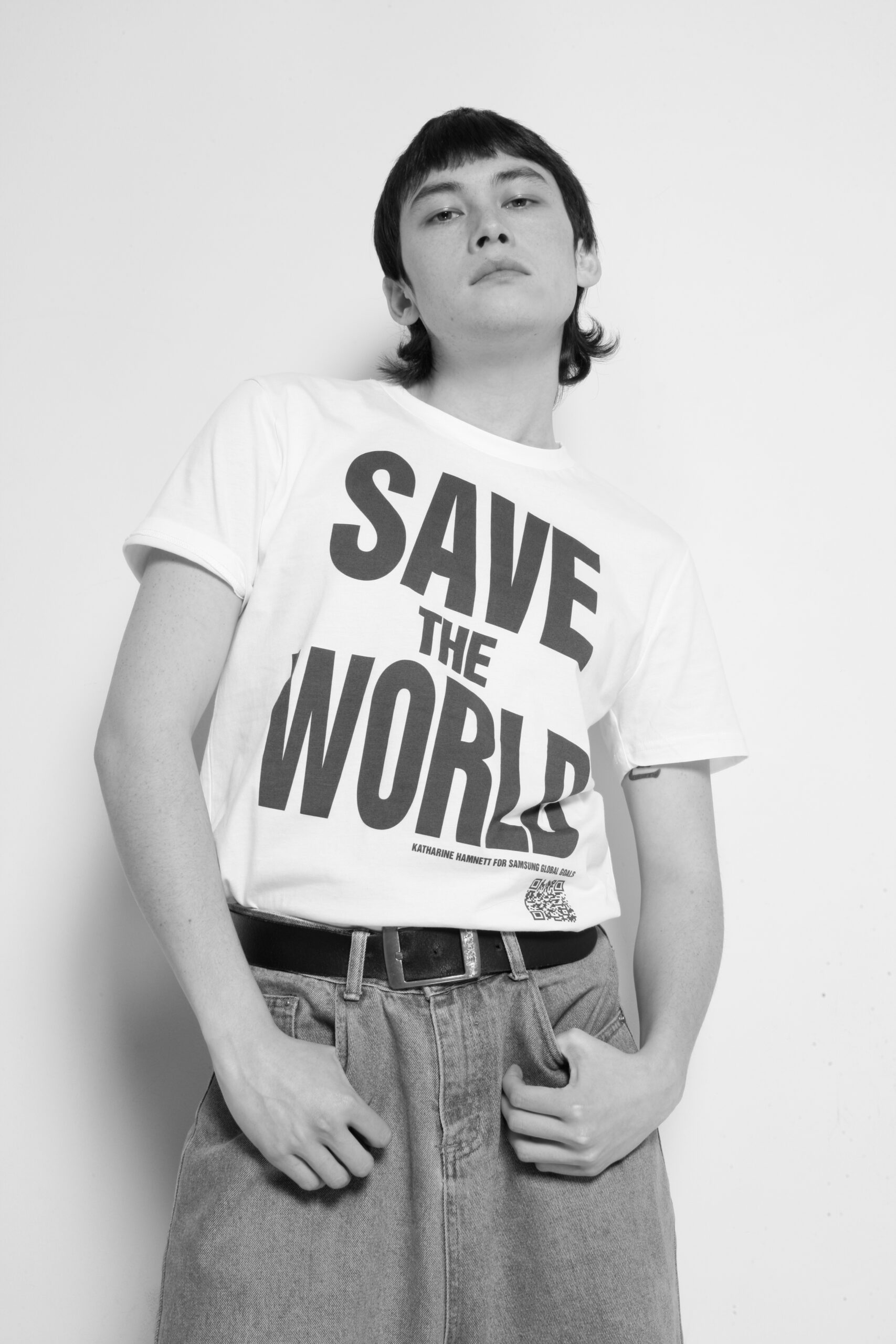
t-shirt. Katharine Hamnett for Samsung Global Goals x UNDP
Christopher Low, environmentalist
Please share a story about your personal activism that you feel encapsulates your mission and ethos.
I’ve always wanted to use my conservation and environmental knowledge in a broader context of communication, and I think engaging different audiences in this discussion encapsulates my personal mission. This year, I will be contributing to a research paper on conserving evolutionary unique species. I’m super proud of being offered this opportunity from my research project at the London Zoological Society, particularly as it highlights the need for science-based communication in society. I’ve also collaborated with a local-based artist, reinterpreting a drawing by Zoologist Ernst Haeckel, which communicated the importance of conserving evolutionary unique species for the research project I did during my Masters. I’m passionate about continuing this kind of intersectional creative work in my activism.
My current work at The Carbon Literacy Project (Climate change charity) looks at action-focused engagement on the climate crisis, and we must highlight the significance of communication within activism. Without effectively engaging with audiences, we’ll never avoid the worst impacts that will hit us further down the line. It reaffirms to me why we need to work on projects like these. I mean, can we solely rely on politicians to sort this mess out? Probably not.
What does the message on the slogan tee shirt you wore in the shoot mean to you? What is your interpretation?
Save the world. It just says it as it is really! We only have one life, one world, and one chance. So you better do all you can to save it, baby! For me, the slogan also resonates with a bigger picture of equality. How can you save a world when the ways in which society functions are cracked? Environmental racism, climate injustice, and the huge infringements of indigenous rights, just to name a few, are all entangled in this. If these fundamental rights can’t be protected, then no world can be saved.
Do you feel like change can be made through the relationship between fashion and politics? If so, how?
Yes, I feel that there needs to be an exchange between fashion and politics, and as we all know, where there’s a will there’s a way! It’s ironic that fashion and politics are apparently so polarised, and yet so intertwined with each other: one can’t change without the other. This is why recognising intersectionality is so important, and projects like V For Vote are spearheading the movement. Fashion appeals to a wide audience and a lot of young people are disengaged with politics, so V For Vote engages different audiences, inspires change within us all, and proves that through fashion and social change, you can actually make a difference.
What are your memories and associations of Katharine Hamnett’s work and career?
My favourite moment from Katharine Hamnett’s work/ time in fashion was when she met Margaret Thatcher. That whole moment was kinda iconic, and I think it was a real testimony to standing up to a political figure. I really admire the statement that she made in fashion and politics. I feel that so much of fashion is now intertwined with celebrity culture, and so I love how this moment challenged the political system at that time. Considering the catastrophic year we have had in politics, a rebirth of this moment feels very much needed.
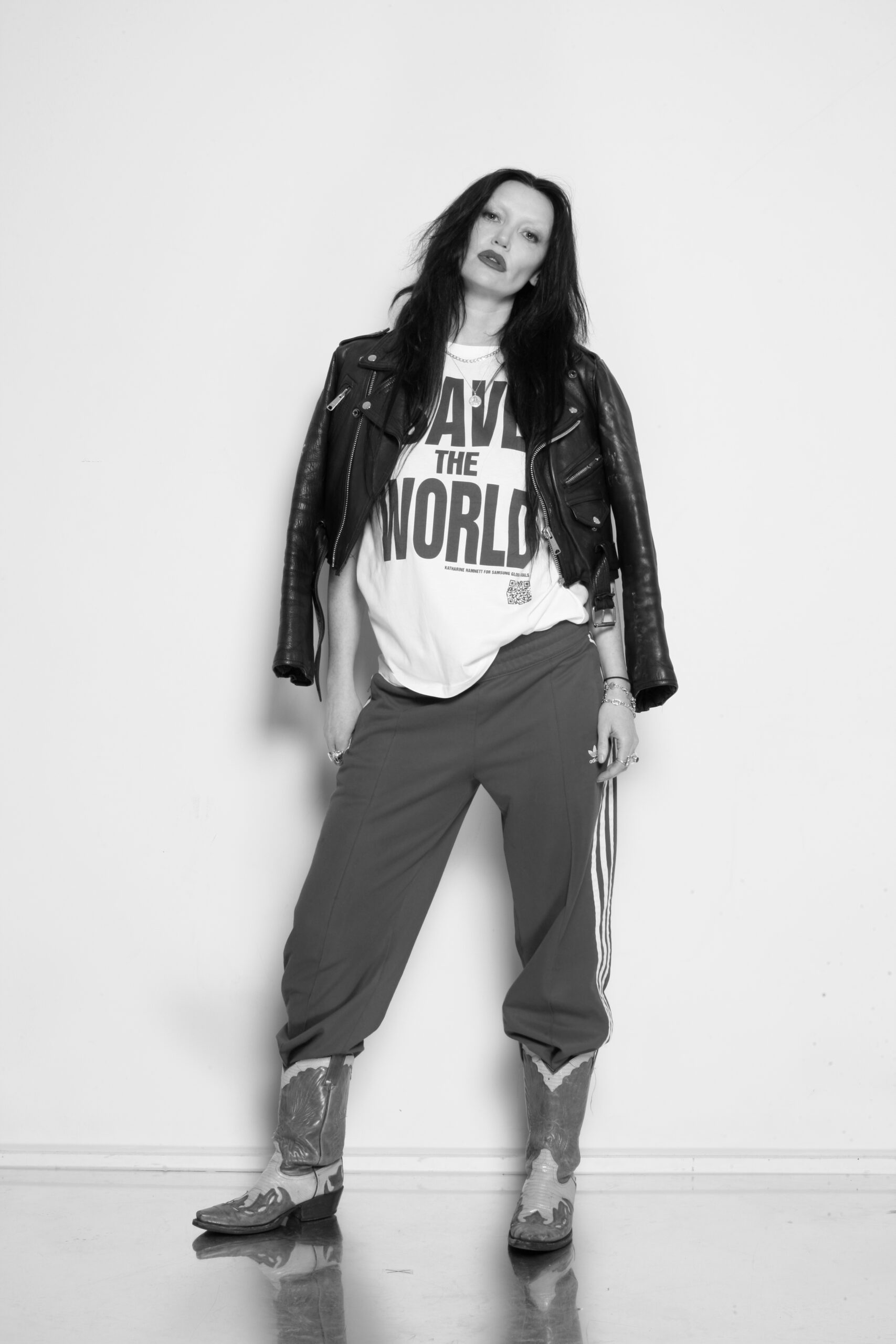
t-shirt. Katharine Hamnett for Samsung Global Goals x UNDP
Fi McCluskey, singer
Please share a story about your personal activism/ mission that you feel encapsulates your ethos.
As a woman I cannot be anything else than a feminist. Through my personal experience as a young girl growing up in Essex, I was perceived as provocative and outspoken which gave rise to people labelling, denigrating and targeting me. This has led me to pay homage to my video for my new single ‘Empty Space’ to the first women who were executed for witchcraft in Essex back in 1566. Agnes Waterhouse and her daughter Joan were executed for being witches but were basically independent women who lived on the fringes of society. What has changed? We all know what happened with abortion rights recently.
What does the message on the slogan tee shirt you wore in the shoot mean/ say to you personally?
The pursuit of individualism has clearly failed us so for me the slogan invokes collectivism for the greater good. Get on board!
Do you feel like change can be made through the relationship between fashion and politics? If so how?
Yes of course. Just look at Westwood and punk. Fundamentally fashion, art and music reflect on society and turn emotion and feeling into something tangible. Katharine has done this by creating uncomfortable conversations and bringing them into popular culture with her iconic T-shirts.
What are your memories and associations of Katharine Hamnett’s work and career?
Choose Life! From an early age, I was aware of Katharine Hamnett’s T-shirts – watching artists like George Michael and Boy George as well as people on the streets wearing them gave me hope that there were like-minded people out there before I could articulate my own identity.
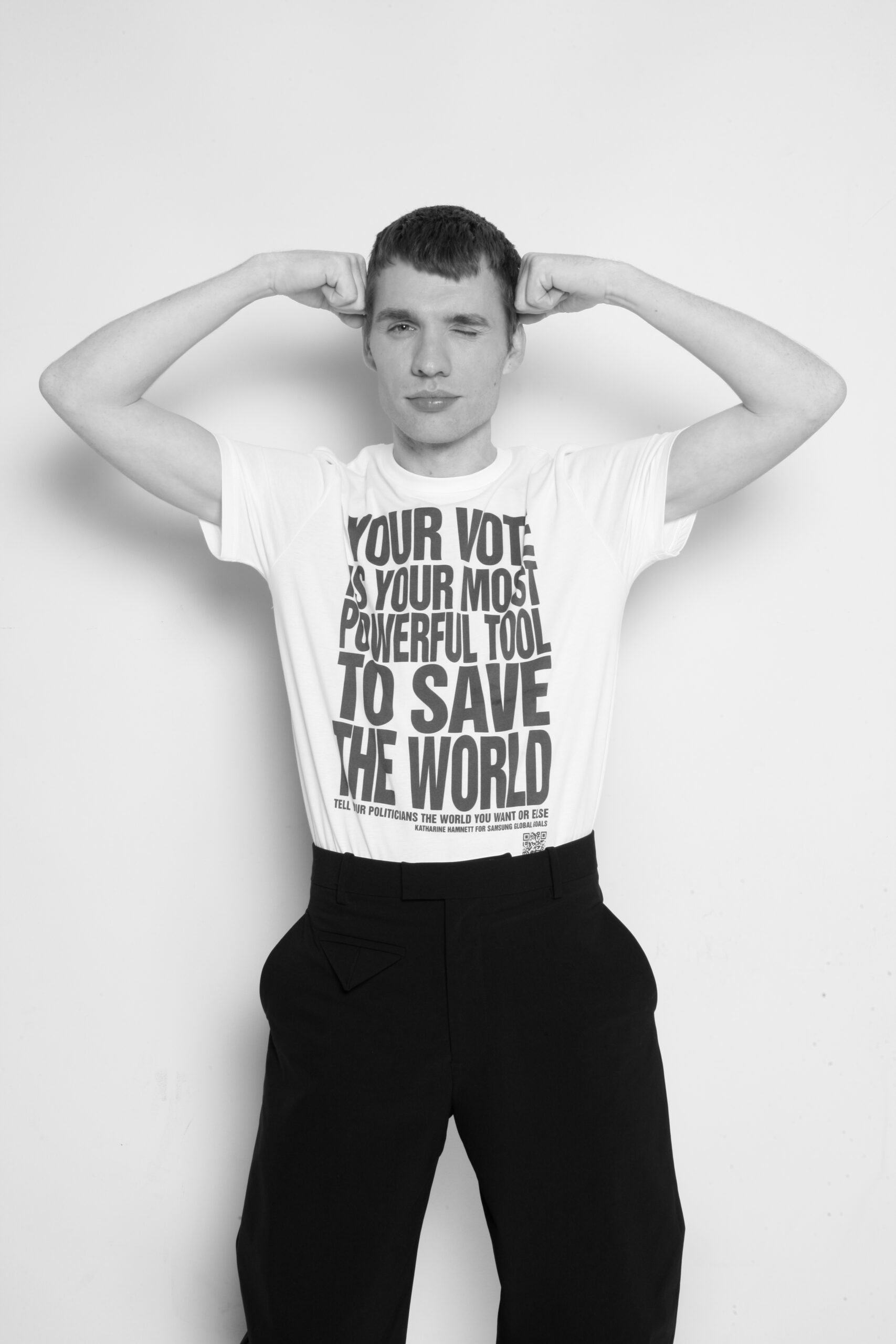
t-shirt. Katharine Hamnett for Samsung Global Goals x UNDP
Alan Goddard, stylist
Please share a story about your personal activism that you feel encapsulates your mission and ethos.
In my styling work, I have always wanted to create conversation. I like to blur the lines of gender, drawing from my own queerness and not wanting to fit everyone into specific categories. This to me is my form of activism, especially with what we are seeing develop politically across the world regarding LGTBQ+, gender & trans rights.
I have also always been a strong believer in getting out in the streets and letting our voices be heard. I have lived in Italy for the past seven years and coming from London where protesting and gatherings of political response are common, we are only just started to see protests on a larger scale starting with the BLM movement and most recently with the gathering of 10,000 in Milan to defend the rights of LGBTQ+ families as legislation is currently being put in place to ban same-sex couples from adopting children. To be a part of this and to witness that volume of people come together within three days’ notice shows that a change in the attitude toward activism in Italy is happening.
What does the message on the slogan tee shirt you wore in the shoot mean to you? What is your interpretation?
It’s a long one but well worth the read `Your vote is your most powerful tool to save the world, tell your politicians the world you want or else`. It’s clear and strong in meaning. The slogan is very personal to me as voting has affected many aspects of my life, firstly as a gay man and secondly as a Brit living outside of the UK. We live in a world where not voting can change everything, which has become very evident in the last 10 years. I remember when the Brexit results were confirmed, I was speechless, less for myself but more for the future generations. This is why it’s important for transparency and education when it comes to voting, we should all be using this tool to let our voices be heard.
Do you feel like change can be made through the relationship between fashion and politics? If so, how?
100%! I think we need to stop thinking of fashion as just a beautiful image or garment, it’s a way of getting across a message and making a statement. By being unapologetic in this I believe change will come. For myself as a stylist, it’s always been important to show my personal point of view on political topics. Designers such as late Virgil Abloh and Ludovic de Saint Sernin are clear examples of visionaries who were/ are pushing boundaries and not being scared to put political messages at the forefront of their brands, whether that be race or sexuality, even in periods of political unease.
What are your memories/ associations of Katharine Hamnett’s work/ career?
I have been familiar with Katharine’s slogan manifesto since my fashion studies, but my first significant memory has to be on set shooting Katherine’s collection campaign, I was assisting stylist Namalee Bolle. I remember opening a book on Andy Warhol that was in the library of the photo studio and staring up at me was a photo of Andy and Katharine together, with Katharine wearing one of her infamous slogans. If that image alongside the one of her meeting with Margaret Thatcher doesn’t signify the impact Katharine has had on the world of fashion, politics and contemporary culture I don’t know what will! She then walked into the studio as I looked up, full of energy and giving us one of her political speeches, talking with such passion. I thought to myself ‘I could listen to her talk for days!’ She is such a character and still of such strong opinion and for that reason, it is always inspiring to be around her.

Owen Jones, writer
Please share a story about your personal activism that you feel encapsulates your mission and ethos.
When I helped organise the protests against Donald Trump’s state visit to Britain, we focused on elevating voices from those communities most affecting – like Muslim people and trans people – and that for me has always been crucial: representation has to be at the heart of fighting for a world free of injustice.
What does the message on the slogan tee shirt you wore in the shoot mean to you? What is your interpretation?
My understanding of ‘vote’ is about struggle: our ancestors fought for this right at great cost and sacrifice, and while the act of voting is important, the spirit of how this right was won is equally as important: we only change the world by fighting back.
Do you feel like change can be made through the relationship between fashion and politics? If so, how?
Yes, as this feature shows! We’re emotional creatures and it’s a mistake to think politics can just be won by reasoned arguments: you have to appeal to people’s feelings, and fashion does this in an often raw and direct way.
What are your memories/ associations of Katharine Hamnett’s work/ career?
Her ‘WORLDWIDE NUCLEAR BAN NOW’ t-shirts were so compelling because they tried to raise awareness of the most important issue of all: the future survival of our species.
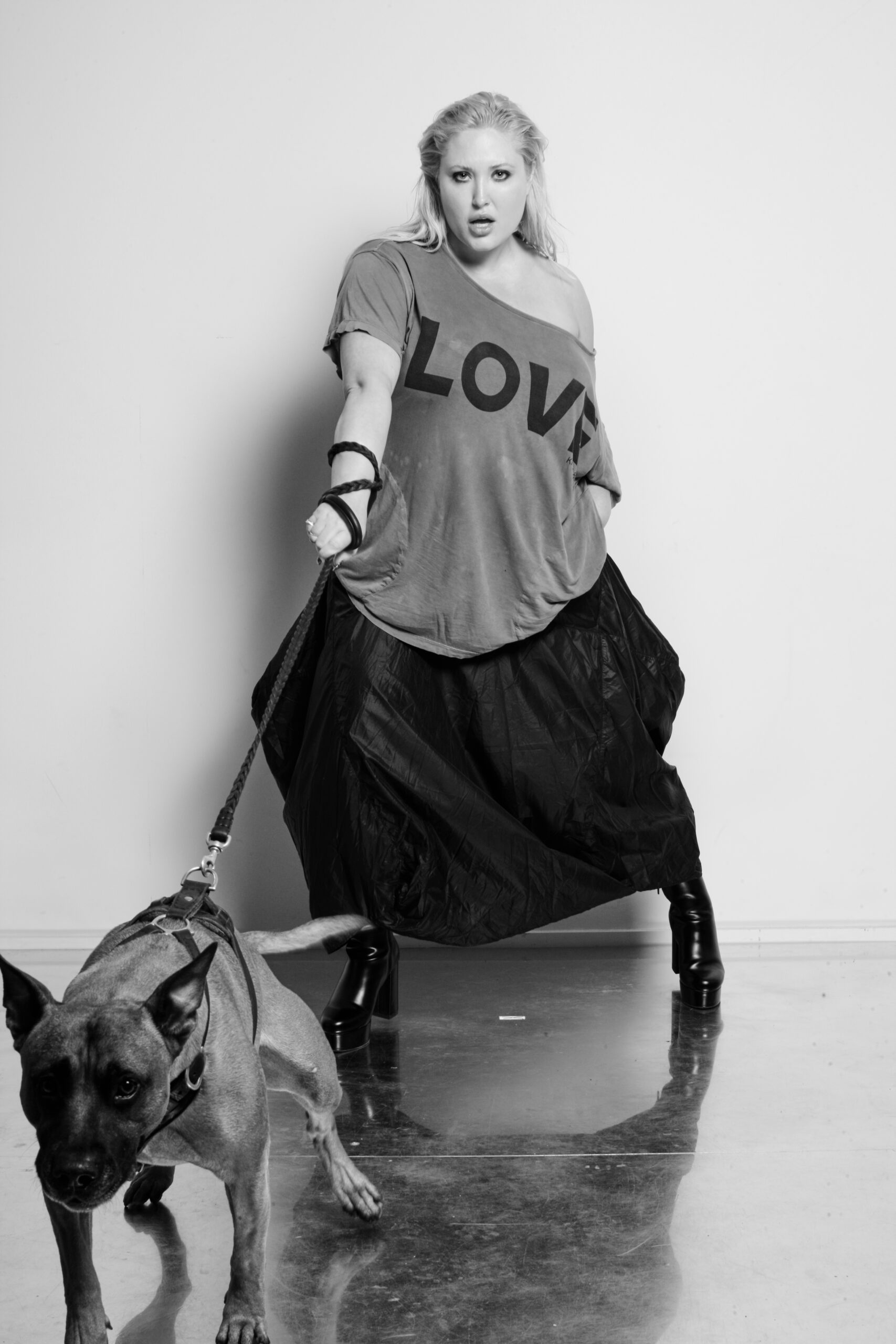
t-shirt. Katharine Hamnett for Samsung Global Goals x UNDP
Hayley Amber Hasselhoff, actor/model/activist
Please share a story about your personal activism/ mission that you feel encapsulates your ethos,
My mission is to help people understand the power that is within them and that they are worthy right here, right now; whether that be around our relationship with our bodies, or our mental health. I started in this industry at the age of 14, recognising there were girls who looked like me with the same bodies and challenges, feeling like it wasn’t OK to love who they were. It led me to understand I could speak my truth through the curve industry and in turn help her/him/them find peace with their ever-evolving bodies. I was blessed to feel celebrated in my size during shoots when we weren’t being represented, so I knew it was my duty to try and encourage others to feel okay on our good AND bad body days. We ALL have them but for me having a good outfit on would help me combat that bad body day to conquer whatever was ahead of me. This is why I got into fashion hosting and makeovers to help others feel what I felt. And to live in a full state of lack of self-judgement on the days we don’t feel connected to our bodies.
Over the past couple of years, I really focused on the connectivity between body image and mental health. How our lack of love for our bodies can be the first that goes when we aren’t taking care of ourselves and building a GIANT personalised toolbox for our challenging moments in life. Over the pandemic, I built an InstaLive series called Redefine You: A Conversation For Well-Being that then turned into a podcast with CBS where I spoke to friends in the industry people about their personal achievements, rather than their professional ones. It showcased how many of us are silently suffering as you never know what is prospering behind the scenes while someone is live on camera. I just went to Utah and got to visit four different mental health programs for adolescent kids aged 12 to 17 years of age. There is a huge epidemic happening that we need to speak up and speak out about. What I heard was that the biggest condition that was being transferred between the kids at the mental health programs was eating disorders. We must showcase that the beauty you truly are, is right here, right now. I won’t stop trying to help others feel the power within themselves as when one shows vulnerability, it encourages us all to look within too.
What does the message on the slogan tee shirt you wore in the shoot mean/ say to you personally?
Love for others and love for oneself! When we take the time to stop for a moment and think ‘How can I put more love into this?’ our heart stops, we humanize the situation and we feel the abundance of connection between the two. Self-love to me is living in a place of radical acceptance: the love we have for how we evolve over time and the grace we give ourselves to live without self-judgement. When we speak to ourselves negatively on the days of doubt, we shut off this idea that it’s okay to not be okay all the time. The love we show ourselves is of utter importance to allow us to see love in others even if we may not agree with their beliefs. THAT’S OKAY as long as we lead with love during a conversation of opposition. Love is passion. Love is curiosity. Love is strength. Love is power in being you. Love can bring a world of two different backgrounds together in unity of what their hearts speak and nothing more.
Do you feel like change can be made through the relationship between fashion and politics? If so how?
Fashion is a universal language: one in which we can make a movement through as a collective understanding of either appreciating the art of fashion or just as simple as needing to get dressed in the morning. Politically I think the more brands that use their platform to express what their beliefs are and what they stand for and stand against it will bring in an audience, a tribe that is there to not just wear their clothing but beam in it with pride to help raise awareness on key issues that are dear to ones hearts. As we have seen last year with women’s rights being impacted worldwide the slogans worn on T-shirts have a huge impact in media that is driven across the globe. It showcases their message without speaking individually however all in unity to work towards making the change happen and the allyship in the media produces for others to join in countries that are only aware of that one photo of that one woman wearing her heartfelt message on her chest.
What are your memories/ associations of Katharine Hamnett’s work/ career ?
What I have found in my career of activism is that it isn’t just the people in the industry who impact to make change. The real change happens when we impact just one person who then believes in the cause to educate another. Knowledge is power and sometimes needs to be explained. Something as beautiful as Katharine Hamnett’s “CHOOSE LIFE” shirt to shift the conversation around refugees didn’t start with saying ‘Help Refugees’ – it humanized the issue and began a conversation to all those around. Like music, fashion can be interpreted in many different ways that collectively impact your personal life and journey. To use your platform to start conversations is the first goal, to keep the conversation going is the last goal. Whatever opinion someone may have, at least the conversation is being had and education on a topic is being produced.
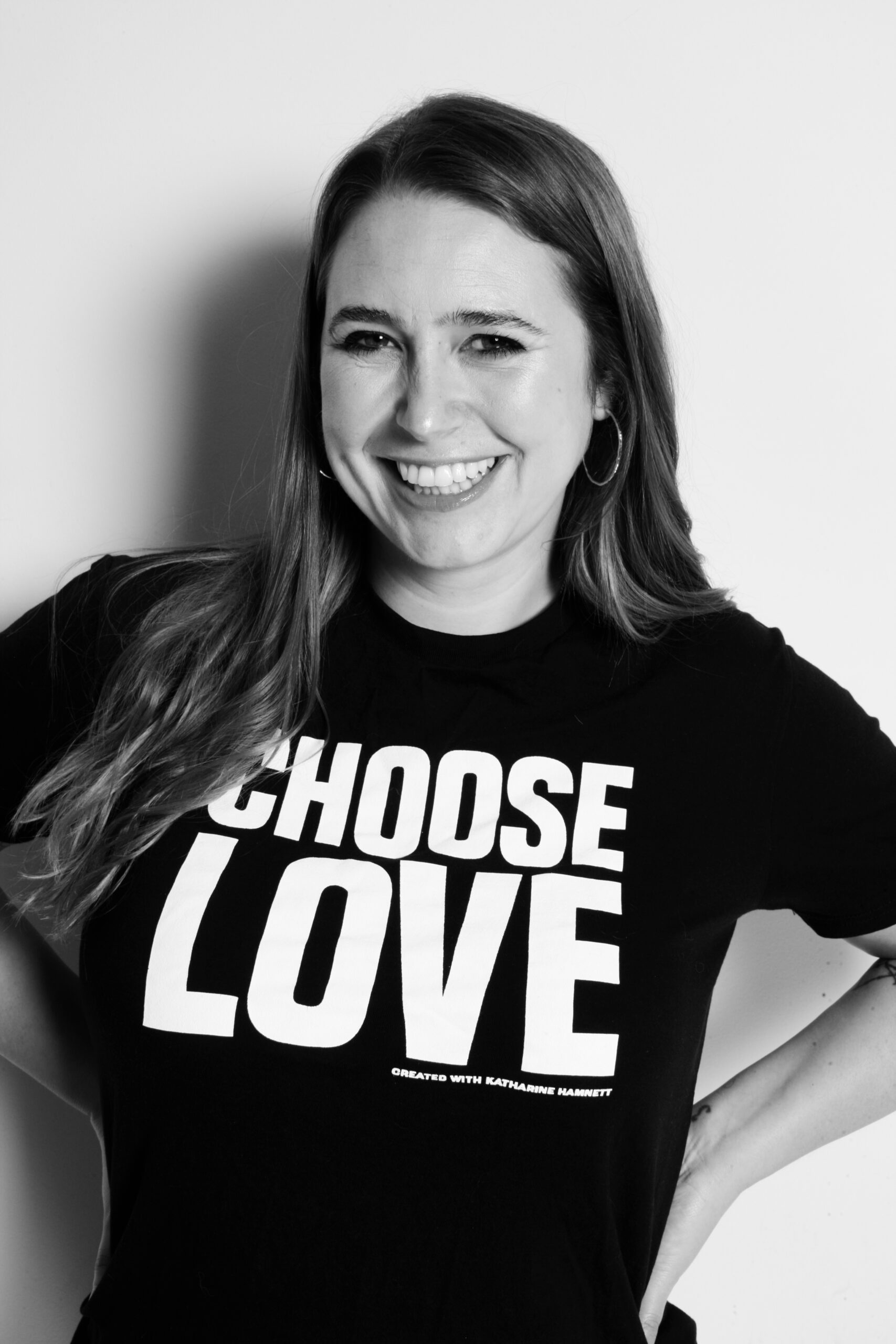
t-shirt. Katharine Hamnett for Samsung Global Goals x UNDP
Josie Naughton, Co-founder and CEO at Choose Love
Please share a story about your personal activism that you feel encapsulates your mission and ethos.
“The Origin Story” of Choose Love best encapsulates our mission as an organisation. In 2015 over 1 million people arrived in Europe seeking sanctuary. Governments and large institutions did not respond and civil society was forced to take matters into their own hands. We were part of a movement that believed in welcoming people and supporting them after they had made unimaginable journeys. Choose Love wants to build a world that chooses love and justice every day for everyone.
What does the message on the slogan tee shirt you wore in the shoot mean to you? What is your interpretation?
When our organisation needed a T-shirt, we were so lucky to be connected to Katharine. At the time, refugees were being vilified in the media and we weren’t sure what message to have. Katharine and her team connected to the humanity of our work, people helping people and donated “CHOOSE LOVE”. This phrase is incredibly powerful because it cuts across politics and reminds us that we can choose how we respond to our fellow humans even if they can’t choose the situation that they find themselves in.
Do you feel like change can be made through the relationship between fashion and politics? If so, how?
Fashion is an incredibly important part of social change and social movements. For change to happen you need the will of the people to influence people in positions of power and fashion is one way for people to state their beliefs and come together as a community. Katharine’s t-shirts give people a way to express how they feel, we often say “CHOOSE LOVE” is a badge of compassion on people’s chests. Over the last 8 years in moments of political turmoil around issues of forced migration, we see politicians and people in the street wearing their “CHOOSE LOVE” t-shirts, and we believe this contributes to pressure on decision-makers.
What are your memories/ associations of Katharine Hamnett’s work/ career?
Katharine’s long career is inspirational on so many levels. She’s the queen of sustainability and together with Vivienne Westwood she showed us how fashion can be a voice. Of course, Katharine’s meeting with Margaret Thatcher in her “58% DON’T WANT PERSHING” t-shirt stands out as an iconic moment of bravery. I have had the great privilege of becoming friends with Katharine over the years and her courage is one of the most incredible things about her.

t-shirt. Katharine Hamnett for Samsung Global Goals x UNDP
Christy Brooks, model & artist
Please share a story about your personal activism that you feel encapsulates your mission and ethos.
One significant experience in my journey was organizing a youth-led climate strike in my community. Recognizing the pressing need for immediate action to address the climate crisis, I felt compelled to mobilize fellow young people and raise awareness about the urgency of the issue. With the support of like-minded individuals and local environmental organizations, we planned a climate strike that aimed to send a powerful message to our community and policymakers. Our goal was to demand bold and transformative action to combat climate change, protect our planet’s ecosystems, and secure a sustainable future for ourselves and future generations
The strike not only drew attention to the climate crisis but also served as a catalyst for dialogue and action within our community. We distributed educational materials, engaged in conversations with members of the public, and urged local leaders to prioritize climate change mitigation and adaptation in their policies. solutions.
What does the message on the slogan tee shirt you wore in the shoot mean to you? What is your interpretation?
“Save the world” means acknowledging the urgent need to address pressing global issues such as climate change, environmental degradation, social injustice, inequality, poverty, and more. It highlights the interconnectedness of these challenges and emphasizes the importance of finding sustainable solutions that benefit both people and the planet.
“Save the world” also embodies the idea that every individual has a role to play in creating positive change. It emphasises the power of collective action and encourages people to engage in activism, whether through grassroots movements, advocacy, education, or personal lifestyle choices. It recognises that small actions, when multiplied, can lead to significant shifts and have a ripple effect on a larger scale.
“Save the world” reminds us of the importance of empathy and compassion. It calls for a reevaluation of our relationship with nature and with each other, encouraging us to prioritise cooperation, respect, and solidarity. It involves recognising the inherent value and interconnectedness of all living beings and working towards a more harmonious and sustainable coexistence.
Ultimately, the message “save the world” is a reminder that we have the power and responsibility to shape the future we want to see. It calls for a collective effort to address the urgent issues facing our planet and to create a more just, equitable, and sustainable world for present and future generations.
Do you feel like change can be made through the relationship between fashion and politics? If so, how?
Fashion can influence politics by challenging societal norms and fostering cultural shifts. By promoting diverse and inclusive representations in fashion campaigns, challenging beauty standards, and embracing sustainable and ethical fashion practices, the industry can contribute to a broader cultural change that values environmental sustainability and social justice.
Fashion can also contribute to circular economy principles by emphasizing the importance of recycling, upcycling, and reducing waste. By promoting clothing rental services, secondhand markets, and sustainable fashion initiatives, the industry can help reduce the environmental impact of fashion production and consumption.
What are your memories/ associations of Katharine Hamnett’s work/ career?
My memories and associations of Katharine Hamnett’s work are rooted in her iconic political statements through fashion. I recall her oversized, unisex T-shirts emblazoned with provocative slogans like “Choose Life” and “58% Don’t Want Pershing,” which became symbols of protest and self-expression in the 1980s. Hamnett’s commitment to sustainability and ethical fashion practices is also a noteworthy aspect, making her work a source of inspiration for those interested in environmentally conscious design. Her ability to blend activism and fashion has left a lasting impact on the industry and continues to influence how we view the intersection of style and social consciousness.

t-shirt. Katharine Hamnett for Samsung Global Goals x UNDP
Bilal Alfawaz, actor & boxer, CEO of FitNation
Please share a story about your personal activism/ mission that you feel encapsulates your ethos
I spoke recently at the One Young World Summit in regard to the effects of human trafficking on the individual and ways to make it stop. The legal asylum system in the UK is convoluted and ambiguous at best. I try, through my personal story, to increase awareness for others who may be going through the same issues that I am but who don’t have my voice.
What does the message on the slogan tee shirt you wore in the shoot mean/ say to you personally?
My slogan is ‘Use it or lose it’ – I am privileged enough, despite my situation to have a voice and a talent that allows me to speak and for people to listen. As the saying goes, “I am just one person, said 7 million people.” If we use our voices together the world has to hear.
Do you feel like change can be made through the relationship between fashion and politics? If so how?
Fashion is a medium for the masses. The simplicity of slogan T-shirts means that anyone can be a statement no matter how insignificant they feel. If you don’t feel you can speak up then allow what you wear to do the talking.
What are your memories and associations of Katharine Hamnett’s work and career?
Katharine Hamnetti is a trailblazer. From the early days of Margaret Thatcher and Pershing to the present, her work alongside other fashion luminaries is changing the landscape we see before us.
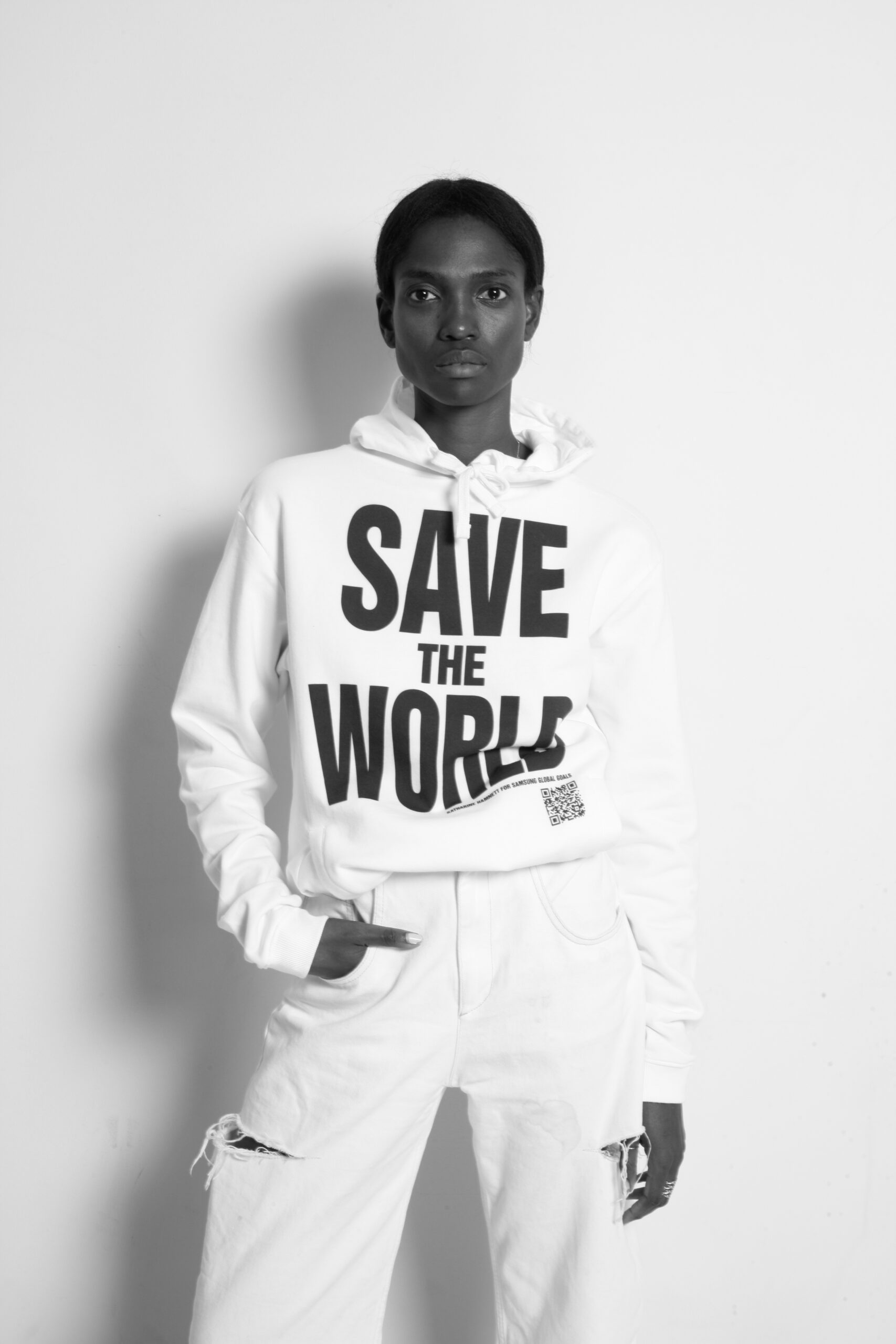
hoodie. Katharine Hamnett for Samsung Global Goals x UNDP
Ooooota, entrepreneur
Please share a story about your personal activism that you feel encapsulates your mission and ethos.
I don’t feel a single story encapsulates my mission or activism. Many experiences have shaped my commitment to creating an open world which judiciously uses its resources and cares for its people.
What does the message on the slogan tee shirt you wore in the shoot mean to you? What is your interpretation?
The slogan “save the world” means we need to actively fight against our complicity in its destruction. Even doing nothing is enabling its destruction. Our world is as much our immediate surroundings as it is communities and forests hundreds of miles away.
Do you feel like change can be made through the relationship between fashion and politics? If so, how?
Change can be made when we realise that every aspect of our life is or can be politicised. It’s, therefore, our responsibility to be aware of how our choices, lifestyle and profession, factor into politics, and to ultimately reclaim our civic agency. Conversation across sectors is always beneficial.
What are your memories and associations of Katharine Hamnett’s work and career?
Katharine standing up against corporate/political interests. I respect protest when it’s for the greater good!
Katharine Hamnett for Samsung Global Goals x UNDP T-shirts and hoodies are available at wearethefuturesdgs.com. 20% of all sales are donated to UNDP for their work on achieving the Global Goals.
photography. Jean-François Carly
creative direction. Namalee Bolle
styling. Alan Goddard
text, concept + production. Ninette Murk
hair + makeup. Nina Fay Robinson using MAC
special thanks. Ian Loughran at One Management, Carola at Anti Agency and Nicole at Nicole Levy PR
featuring. Olivia Arben, Owen Jones, Jonbers Blonde, Bishi, Alan Goddard, Namalee Bolle, Caryn Franklin, Meryl Fernandes, Cozette McCreery, Yasmin El Yassini, Fi McCluskey, Christopher Low, Daniel Millar, Roxy Murray, Jonny Woo, Hayley Amber Hasselhoff, Josie Naughton, Christy Brooks, Bilal, Ooooota.













